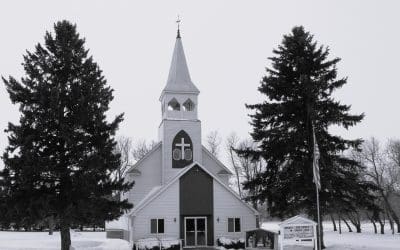Written by Pastor Jason Gudim
Why is an Intentional Formation Strategy Important in a Congregation? (Part 2)
“Repetition, repetition, repetition.”
We are formed through the liturgy. The expression and importance of the church year is realized through each individual worship service. Each worship service should highlight the regular tension of Law and Gospel for believers.
Now, I am no curmudgeonly hater of “contemporary” worship just because it’s new. I’m also not a traditionalist for tradition’s sake (although I personally prefer a traditional, more liturgical style of worship). I would actually like to direct our attention away from “style” and focus rather on the emphasis and content of the worship service.
Does the worship service you attend focus on what you can, are, and should be doing for God, or does it focus on what God has, does, and will continue to do for you?
I would argue that the former, while well-intentioned, runs the risk of leaving us exhausted and drained. Certainly this is a generalization, but my concern with self-centered worship is that it inverts the Law/Gospel tension in such a way that we move past the Gospel in an effort to live in the Law. We are always trying to work up the emotions worthy of God’s identity, and then we are given something to do in response to God’s activity—we are called to do more, try harder, and be better. The Christian is always doing at the cost of rarely, if ever, receiving.
But a worship service that focuses on what God has, does, and will continue to do rightly orders Law and Gospel and in the proper tension. These liturgies (and a liturgy is simply an observed order of service) force us to confront and confess our sins, but then immediately highlight and apply the Gospel reality of Christ’s death and resurrection for those sins. This tension happens multiple times throughout the service: confession and absolution (and/or confession of faith), the Scripture readings, the sermon, and the observance of the Sacraments.
Beyond this, the liturgy of a God-centered worship service is designed to bathe the Christian in the assurance of salvation in order that he or she goes out from that place ready to live the Christian life. In receiving the benefits of God’s activity for us, we are free to love and serve our neighbor in our vocations. This repetition forms us in the faith on a weekly basis as the truths of Scripture and the Truth of Scripture—the Good News of the Gospel—are taught and applied to each one of us.
We are formed through catechesis. The word “catechesis” (and related words: catechumen, catechism, etc.) come to us from the Greek word katecho, which is where we have derived the English word “echo”. Catechesis involves a teacher asking a question and a student responding with an expected answer. In this way, the truth of the faith is sounded back and forth between teacher and student.
Catechesis has been the primary way of teaching the faith since the NT. It is reflected in the idea of holding fast to what we have been taught from the Word of God (cf. Luke 8:15; 1 Thess. 5:21; Heb. 3:6). Similarly, Paul encourages Timothy to “continue in what you have learned…from childhood,” (2 Tim,. 3:14-15). If we are to confess and live out the faith, we must be taught the faith.
This notion stands in contradistinction to the ever-popular “deeds not creeds” movement. In these movements, throughout history, Christians have emphasized personal activity and improvement over the study of doctrine. Doctrine ends up being an exercise of “dead orthodoxy” and ivory tower academia rather than a communication of the truth of God’s Word. In these systems, “doctrine divides”, and true unity is a matter of performance and expression of the will rather than confession.
Because of this, I would argue that we as Christians—no matter how long we’ve believed or how mature in the faith we may be—need to constantly be returning to the basic and foundational truths of our faith. We need to realize that doctrine doesn’t divide—it delineates and distinguishes. Doctrine delineates truth from error and doctrine distinguishes areas of disagreement that make true and actual unity impossible because of contrary understandings of God’s truth in God’s Word. Faith that is truly orthodox can never be dead.
For this reason, books like the Small Catechism are invaluable. Martin Luther intended the catechism to be a manual for the Christian life meant for constant review, stating, “I am also a doctor and preacher…Yet I act as a child who is being taught the catechism. Every morning—and whenever I have time—I read and say, word for word, the Ten Commandments, the Creed, the Lord’s Prayer, the Psalms, and such. I must still read and study them daily. Yet I cannot master the catechism as I wish. But I must remain a child and pupil of the catechism, and am glad to remain so,” (Longer Preface to the Large Catechism, 7-8).
Luther ordered the catechism in such a way that both its structure and content not only highlight the tension of Law and Gospel for the Christian life, but also apply it to our lives and teach us how to live it out practically.
The structure of the catechism moves from Law (primarily in the Ten Commandments) to Gospel (Creed, Lord’s Prayer, Sacraments) to vocation (Table of Duties). The call to serve our neighbor in our vocations then cycles us back to the Ten Commandments where God’s Law again teaches us what that love and service must look like, both for God and for neighbor.
The content of the catechism expands on this. The Ten Commandments teach us both what is in bounds and out of bounds for the Christian life. For every sinful behavior that God prohibits in the Ten Commandments, he simultaneously promotes the opposite virtuous behavior. As we become convicted of our sins through our disobedience to God’s Law, we immediately move to the Creed which highlights the Gospel in God’s various activities of creation, redemption, and sanctification. The Lord’s Prayer likewise highlights the Gospel in that we are instructed to pray for what God has already promised to be doing for us. The Sacraments identify the importance of the external and applied Word. We aren’t left to merely to wrestle with God’s promises in our minds and hearts and fallible consciences, but rather are directed outside ourselves to believe and receive God’s promises as objective truths which are for us. Finally, the Table of Duties communicates to us the purpose of our good works. God doesn’t need my good works (because he’s God). I don’t need my good works (because I have everything I need for life and salvation in Jesus Christ). But my neighbor needs my good works (because God provides daily bread to all people through the love of neighbors in the various vocations he has called us to).
We are formed in the faith through review and repetition of these core and foundational concepts communicated in the Small Catechism. The Small Catechism and other confessional documents were never meant to replace Scripture. They were instead intended to organize the truths of Scripture in easily communicated and learned ways.
The Christian life is surprisingly simple, but it is not easy. Through the repetition of the church year, the liturgy, and the truths of the faith communicated in the catechism, we will be formed and anchored in the faith, and in turn “the faith” will become our faith—a faith that we believe, teach, confess, and live out on a daily basis.
(Check out Part 1 to find the first way that Pastor Gudim lays out how Christians are formed in the faith through Scripture. )
The Lutheran Church PLanter
Join us on your favorite podcasting platform for church planting encouragement and practical tips.
Let's connect
Interested in learning more about how you can be part of a church planting movement in this generation? Reach out to start a discussion!
Recent Posts
The Theology of the Local Congregation: A Primer for Church Planters
The Theology of the Local Congregation: A Primer for Church Planters I have been asked to contribute a series of articles focusing on the...
Lessons Learned in a Church Plant
Lessons Learned in a Church Plant "Pastor Elden Nelson served as a previous AFLC Home Missions Director for many years. That time was a unique time...
Lessons Learned in Rural Church Ministry
Lessons Learned in Rural Church Ministry Near the beginning of his classic biography on Martin Luther (Here I Stand), Roland H. Bainton...





0 Comments